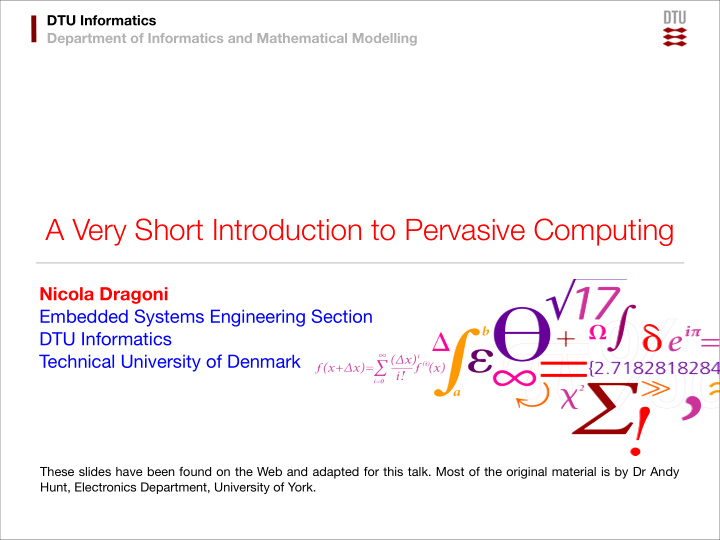



DTU Informatics Department of Informatics and Mathematical Modelling A Very Short Introduction to Pervasive Computing Nicola Dragoni Embedded Systems Engineering Section DTU Informatics Technical University of Denmark These slides have been found on the Web and adapted for this talk. Most of the original material is by Dr Andy Hunt, Electronics Department, University of York.
DTU Informatics Department of Informatics and Mathematical Modelling What’s in this Room? • Anything electronic which processes information Typically we find ‣ Mobile Phones ‣ PDAs ‣ Laptop computers ‣ Games consoles (hopefully turned off...) ‣ Mp3 players • Any other info processing devices? 2
DTU Informatics Department of Informatics and Mathematical Modelling What Else is Here? • Passive information storage ‣ Bank cards with chip-&-pin ‣ Products with RFID tag • Anyone got a device inside? ‣ Pacemaker ‣ Diabetic insulin release 3
DTU Informatics Department of Informatics and Mathematical Modelling Energy Processing • Humans used own energy ‣ Helped by animals ‣ and devices • Industrial revolution ‣ Energy was harnessed or generated (e.g. steam engines) ‣ Expanding human physical power 4
DTU Informatics Department of Informatics and Mathematical Modelling Energy Processing (2) • Energy decentralised ‣ Power stations ‣ National Grid – distributed power ‣ Individual engines – mobility • Energy made pervasive ‣ Application-driven devices ‣ Battery power ‣ Miniaturisation 5
DTU Informatics MAINFRAME Department of Informatics and Mathematical Modelling ERA Information Processing • Humans used own brainpower ‣ Helped by paper ‣ and devices • Computer revolution ‣ Information was harnessed ‣ Expanding human mental power ‣ 1940s: IBM president I think there is a world market for about 5 computers. 1946: ENIAC: Electronic Numerical Integrator and Computer Thomas J Watson 6
DTU Informatics PERSONAL Department of Informatics and Mathematical Modelling COMPUTING Information Processing (2) ERA • Computing Decentralised • Bill Gates (early 1970s) IBM 360 mid 1960s • PCs A computer on every desktop and in every home Wireless • Laptops Self-powered Multimedia PDP-11: early 1970s < £70 One Laptop per Child: 2007 Sub-notebooks mid-2000s IBM PC Convertible 1986 IBM PC (DOS) 1981 7
DTU Informatics PERVASIVE Department of Informatics and Mathematical Modelling COMPUTING Information Processing (3) ERA • Devices which do NOT look like computers, but : ‣ Process data ‣ Store information ‣ Connect to: other devices and/or the Internet • Pervasive Computing ‣ Focus on the application ‣ Often portable, low-power, always connected 8
DTU Informatics Department of Informatics and Mathematical Modelling Computing Eras • Mainframe ‣ Many people, one computer ‣ Fixed, central location • PC ‣ One person, one computer ‣ Fixed location, decentralised • Pervasive (Ubiquitous) ‣ One person, many computers ‣ The same computer is used by many users 9
DTU Informatics Department of Informatics and Mathematical Modelling The Trends... 10
DTU Informatics Department of Informatics and Mathematical Modelling New User Model! • From ‣ M:1 [MAINFRAME ERA] ‣ .. to 1:1 [PERSONAL COMPUTING ERA] ‣ .. to M:N [PERVASIVE COMPUTING ERA] 11
DTU Informatics Department of Informatics and Mathematical Modelling Pervasive Computing: One Person, Many Devices 12
DTU Informatics Department of Informatics and Mathematical Modelling Pervasive Computing: One Device, Many Users 13
DTU Informatics Department of Informatics and Mathematical Modelling The Father of Pervasive Computing • 1990s: Mark Weiser (Xerox PARC) • First to talk about Ubiquitous Computing • Weiser’s principles (source Wikipedia) Mark Weiser: 1952-99 ‣ The purpose of a computer is to help you do something else ‣ The best computer is a quiet, invisible servant ‣ The more you can do by intuition the smarter you are ‣ Technology should create calm • Please read “ The Computer for the 21st Century ” (1991) http://www.ubiq.com/hypertext/weiser/SciAmDraft3.html • More information here: http://www-sul.stanford.edu/weiser/ 14
DTU Informatics Department of Informatics and Mathematical Modelling Principles of Pervasive Computing • Decentralisation ‣ Mainframe → PDAs and Embedded Computers ‣ Distributed, Peer-2-Peer, Mobile, Small, Powerful • Diversification ‣ Universal → (Task) specific devices ‣ Huge number of new ‘Clients’ • Connectivity ‣ Data exchanged between (always-on) devices ‣ Wireless connection / internet • Simplicity ‣ Seamless interfaces, intuitive, “calm” 15
DTU Informatics Department of Informatics and Mathematical Modelling Scenario: Smart Home 16
DTU Informatics Department of Informatics and Mathematical Modelling Scenario: Pervasive Healthcare • Biological monitoring • Pervasive computing in hospitals • Assistive technologies • Eldercare • Homecare and treatment • Medicine compliance • ... 17
DTU Informatics Department of Informatics and Mathematical Modelling Scenario: Environmental & Green Computing • Monitoring energy consumptions in homes and buildings (sensor network) • Visualizing & Awareness • Pollution monitoring • Garbage handling • Environmental Monitoring 18
DTU Informatics Department of Informatics and Mathematical Modelling Scenario: Smart Spaces • Device intensive environments ‣ i-LAND ‣ GAIA ‣ iSpace / Stanford ‣ Classroom 2000 19
DTU Informatics Department of Informatics and Mathematical Modelling Scenario: Automotive Computing • On-board Computers & In-Vehicle Networks ‣ GPS Navigation ‣ Infotainment ‣ Telematic ‣ Services 20
DTU Informatics Department of Informatics and Mathematical Modelling In General... Smart Objects! • The MediaCup first presented at HUC 1999 • Embed “intelligence” in everyday objects • Sensors, cpu, ... • Wireless connectivity • Now: Internet of Things (IoT) 21
DTU Informatics Department of Informatics and Mathematical Modelling Internet Of Things (IoT) 22
DTU Informatics Department of Informatics and Mathematical Modelling “The most profound technologies are those that disappear. They weave themselves into the fabric of everyday life until they are indistinguishable from it.” [Mark Weiser: 1952-99] 23
Recommend
More recommend